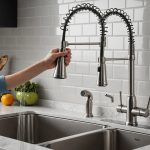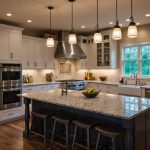Essential Design Tips for UK Kitchens
When it comes to creating the perfect kitchen in the UK, integrating the right layout and materials is vital. An open-plan layout promotes social interactions. It fosters an environment where family and friends can easily gather and communicate while meals are prepared. In addition to enhancing social interaction, it allows for a seamless flow between cooking and entertaining spaces.
Selecting the Right Materials
Choosing durable yet stylish materials is essential for any kitchen surface. Consider using materials like granite, quartz, or solid wood for countertops and flooring. These not only offer resilience but also elevate your UK kitchen aesthetics. Mixing different textures and finishes can further enhance the charm and uniqueness of your kitchen.
In parallel : Revamp your uk kitchen: the ultimate step-by-step guide to designing a chic and functional breakfast bar
Personal Style and Aesthetics
Incorporating personal style is crucial in reflecting individuality within your kitchen. Whether you lean towards a modern minimalist look or a classic countryside style, the key is to blend aesthetics with functionality. Opt for cabinetry finishes and colour palettes that resonate with your taste, ensuring they complement the overall theme of your home. These thoughtful touches can transform your kitchen into a space uniquely yours while maintaining its functionality.
Optimizing Kitchen Layouts for Entertaining
Creating an engaging and functional kitchen space isn’t only about aesthetics; it’s about making the best use of available space too. In UK homes, where space can be limited, incorporating clever kitchen layout ideas is essential to optimize for entertaining.
Additional reading : Elevate your uk kitchen window to a verdant herb oasis: your ultimate step-by-step guide
Importance of the Work Triangle
The work triangle, formed by your stove, sink, and refrigerator, is a fundamental concept in kitchen design tips. It’s crucial because it minimizes unnecessary movement and maximizes efficiency. Designing a compact and efficient triangle is vital for ensuring a smooth workflow, especially when entertaining guests.
Creating Flow for Guests
When hosting, consider how traffic will flow through your kitchen. Optimizing space means allowing guests to move freely without disrupting the chef. Arranging seating areas or islands in such a way that encourages conversation while keeping cooking zones clear is ideal.
Integrating Dining and Cooking Areas
Integrating your dining and cooking areas can transform your space into a convivial hub. By using islands to offer both additional workspace and seating, you not only enhance the UK kitchen aesthetics but create a multi-functional area that encourages social interaction. This setup allows for seamless transitions from cooking to dining, making home gatherings more enjoyable.
Effective Storage Solutions
Maximizing storage space in a kitchen can transform it into one of the most functional kitchens. A smart approach involves integrating clever storage options to keep the area tidy and efficient.
Maximizing Vertical Space
One key strategy is utilizing vertical space, which is often overlooked. Installing shelves or cabinets that reach the ceiling maximizes storage capacity. This not only frees up counter space but also maintains a clutter-free environment. Use the higher shelves for items that are infrequently used and keep daily essentials within easy reach.
Hidden Storage Options
Incorporating hidden storage solutions, such as deep drawers or pull-out pantries, enhances the UK kitchen aesthetics by concealing clutter. These options allow for a more organized kitchen where everything has a designated spot. For instance, consider installing a narrow pull-out cabinet between appliances or a drawer beneath the sink to hold cleaning supplies.
Organizing Tools and Accessories
Proper organization of kitchen tools and accessories is essential for easy access, which contributes significantly to kitchen storage ideas. Use drawer dividers for utensils and labelled bins for categorizing pantry staples. Such thoughtful organization can lead to a more efficient kitchen environment, optimizing every inch of available space.
Lighting Techniques for Ambiance
Creating the right ambiance in a kitchen can dramatically enhance its atmosphere and functionality. One effective method is through layered lighting, which serves different functions and elevates the mood in functional kitchens.
Layering Light for Different Functions
Layering multiple light sources allows for a well-balanced lighting scheme. Ambient lighting acts as the foundation, providing general illumination. It can be achieved through ceiling lights or wall sconces. Task lighting, however, focuses on specific areas, such as countertops or sinks, ensuring tasks like meal preparation are well-lit. Incorporating accent lighting, like under-cabinet fixtures, can highlight key areas, enhancing the UK kitchen aesthetics.
Task Lighting vs. Ambient Lighting
Balancing task and ambient lighting is crucial in kitchen design tips. While ambient lighting offers a soft glow for the entire room, task lighting delivers focused brightness where it’s needed most, such as above cooking areas. This distinction is pivotal for functional and entertaining design.
Incorporating Natural Light
Maximising natural light creates a more inviting space. Large windows or strategically placed mirrors can increase daylight intake, reducing reliance on artificial lights. This not only enhances aesthetics but supports energy efficiency, contributing to a well-designed kitchen ambiance.
Choice of Color Schemes
The kitchen color schemes you choose significantly impact both aesthetics and atmosphere. Understanding the principles of color psychology helps in crafting a space that feels inviting and functional. Warm hues, such as yellows and oranges, radiate energy and positivity, making them perfect for lively kitchen environments. Neutral colors, like greys and creams, offer versatility and can create a calming backdrop, allowing other design elements to shine.
Impact of Neutrals versus Bold Colors
Neutral tones act as a foundation, harmonizing with various styles and materials. They are excellent for framing bold accents or intricate textures. In contrast, bold colors, including deep blues or rich greens, can add drama and focus, transforming a kitchen into an exciting focal point. Balancing these tones ensures a cohesive and functional kitchen design without overwhelming the senses.
Utilizing Accents for Personality
Inviting space can be achieved by thoughtfully incorporating vibrant accents. Features such as colourful backsplashes, statement lighting fixtures, or art pieces inject personality and character. By playing with contrasts, you can highlight architectural features and create a dynamic environment, proving that the right kitchen color schemes elevate the overall ambiance.
Practical Seating Arrangements
To successfully create entertaining spaces in your kitchen, exploring diverse kitchen seating options is key. Thoughtful seating design can enhance interaction and comfort, making your kitchen a hub for socialising.
Designing Breakfast Bars for Socializing
Breakfast bars serve as excellent gathering spots. They offer a relaxed setting, often positioned to allow simultaneous cooking and chatting, promoting conversational engagement. By integrating comfortable swivel stools or high chairs, you can further enhance this interactive setting, making it more enticing.
Combining Seating with Dining
Strategically combining seating with dining areas adds functionality and elegance to any kitchen. It’s essential to choose seating that complements your kitchen’s colour palette and overall entertaining design. Opt for benches alongside tables or dining sets that can serve multiple purposes—ideal for both everyday meals and larger gatherings.
Flexibility in Seating Arrangements
Incorporating flexible seating arrangements is crucial for versatility. Movable furniture, such as folding chairs or extendable tables, allows for adaptability during events or family dinners. This flexibility is especially useful in smaller UK homes, as it aids in optimizing space efficiently. Prioritising comfortable seating ensures gatherings are as enjoyable as they are practical.
Successful Case Studies of UK Kitchen Designs
Exploring kitchen design examples reveals how real-life applications can enhance functional kitchens in the UK. These successful case studies highlight innovative and practical elements that can be replicated in your own home.
Analyzing Real-Life Layout Successes
Examining well-executed UK kitchen layouts often reveals creative use of space and optimizing space techniques. For instance, a narrow city kitchen might successfully integrate an island as both a functional workspace and a seating area, demonstrating the importance of effective kitchen layout ideas. These layouts enhance the social atmosphere and maintain smooth flow in the area.
Innovative Design Elements
Successful designs often incorporate clever storage solutions, adding functionality without compromising aesthetics. Examples include using bespoke cabinetry to seamlessly blend storage with design, or integrating concealed appliances to maintain a clutter-free look. The incorporation of natural materials stands out, exemplifying how to create a warm, inviting kitchen atmosphere while showcasing UK kitchen aesthetics.
Lessons Learned
Key takeaways from these case studies stress the importance of balancing form and function. Each space should reflect the homeowner’s style while enhancing usability. The focus on practical yet aesthetically pleasing solutions proves vital for creating a kitchen that is both functional and inviting.











